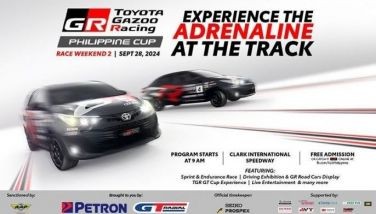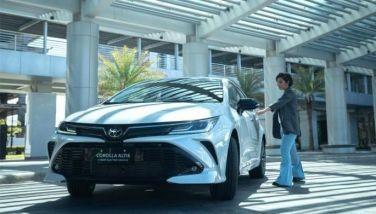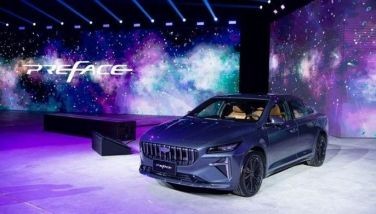An affordable Maserati?
“What is impressive though is the power delivery, which spreads its torque out over a wider curve that makes you lose that whole one-time/big-time acceleration feeling that lasts as long as a politician’s promise.â€
Sounds like an oxymoron, huh? Well last weekend, during the recently concluded Trans Sport Show in SMX, Maserati launched the closest thing to one when they pulled the cover off the all-new Ghibli.
Now it will always be painful when a brand as exclusive as Maserati goes mainstream. The mere thought seems as absurd as Rolex offering digital watches. But the sobering truth is that the brand’s survival, just like Porsche, Jaguar and even Aston Martin, depends entirely on their need to finance their exclusive products for the minority by flirting with the majority.
And the Ghibli was developed to do just that. It is at the heart of Maserati’s plan to go from 6,200 cars a year to 50,000 cars by 2015. It is a goal so bold that the company has so far invested 1.5 billion euros, which includes development of their very first diesel engine as well as a new plant in Grugliasco, which was formerly the Bertone plant,that is capable of punching out 135 cars a day.
The idea is to create an economy of scale that brings the Ghibli into a price range that is only a modest premium over a comparable Mercedes Benz CLS, BMW 6 Series Gran Coupe or Audi A7, which in theory is as simple as making a single malt whiskey affordable enough to mix with coke.
Now having said that, while there will never be an easy way to franchise your soul to subsidize your heart, honestly, I think the Ghibli is as good as it gets for a first try.
The design is immediately pleasing, if not slightly familiar. It has all the right curves, lines and cues, even though there were whispers by some of the journalists in attendance of a Peter Schreyer accent on the rear end. That shouldn’t be taken the wrong way, as being compared to Peter Schreyer, even if he does have a Korean accent these days, is still a compliment. Besides, the front is very Modena. From the side, the lines have a symmetrical kick around the belt and shoulder, which effectively draws you to the center fuselage that is still heavily inspired by the birdcage.
Compared to the Quattroporte, it is a different expression of the same approach–although at just under 5 meters long––as compared to the 5.26-meter long Quattroporte––it has a completely different personality that opens itself up to a much broader palette. There were those that loved it, and those that didn’t, but while beauty will always be subjective, I can say that I totally get it.
I was able to drive one last year during the international launch in Florence, and after ten minutes or so behind the wheel, those sales figures seem a little conservative. In fact, as I type, I have two friends who have signed up for them.
My test unit, for the morning drive at least, was the first diesel engine in the company’s 99-year history, designed by Paolo Martilleni to churn out a mother-thumping 600Nm of luscious torque that eventually taps out at a fairly modest 275hp.
Firing it up for the first time is like hearing Louie Armstrong trying to sing Pavarotti; but once you get past the blasphemy, objectively I have to say it is the best sounding oil burner outside of an Audi LMP1. Whether it has any place in a Maserati is a topic that can and will be debated until we’re ready for hydrogen, but there’s no doubt that it is an engine that would get a lot of flattering ink had it been in an A7, Gran Coupe or CLS. It’s good. It is just not expected.
To compensate, Maserati worked very closely with a company called Eberspecher, who did some amazing things with two sound actuators that manage to give the diesel a half-decent voice. The result is pretty impressive. It will never hold a candle to the gasoline versions, but at least it’s not tone deaf.
What is impressive though is the power delivery, which spreads its torque out over a wider curve that makes you lose that whole one-time/big-time acceleration feeling that lasts as long as a politician’s promise. The tradeoff is it doesn’t feel as devastating as the numbers would suggest; but once you stop comparing it to its gasoline brothers, there’s plenty there to keep you entertained and more than enough to get you into a lot of trouble.
But if you want the full Maserati experience, the V6 3.0 Twin Turbo with direct injection is still the pick of the bunch. What it lacks in torque it makes up for with a beautifully tuned exhaust note that never got the memo that it was a turbo.
Fed through a super-slick 8-speed ZF box, the Ghibli cuts and slices through corners with the grace of cars with half its doors. It doesn’t feel as serious as a 5 Series, but it seems to give itself more room to be itself with double wishbones up front, five links in the rear, and a perfect 50/50 weight distribution with two-stage dampers that perform far better than Skyhook.
Steering is sharp, alive, talkative and communicates well with the chassis. In the Q4 (AWD) versions, steering feel is taxed to pay for the extra grip, but feels like a fair enough trade. Throw it into a corner, power out, and the Ghibli feeds the power democratically to all four wheels and adjusts the allocation every 150 milliseconds, giving you just enough to get you out of trouble while still giving that rear wheel bias that is an inherent trait of every proper sports car––even though the purists will still appreciate the honesty of an exclusive rear-wheel drive.
The interior can still proudly wear an embossed trident on its hide, but some may still look and yearn for that opulence that we normally associate with Maserati. Still, it is right up there with anything BMW, Mercedes and Audi can throw at it. Every detail follows a flow, from the design of the analog clock to the brushed aluminum key that carries the theme from the steering wheel. There’s a split cockpit design with a very functional 8.5-inch touchscreen, a 1280-watt, 15-speaker Bowers and Wilkins premium sound system, and a 60/40 split-fold seat that keeps things very sensible.
And unlike the Audi A7, Mercedes CLS and Porsche Panamera, the Ghibli offers a standard fifth seat. And while BMW’s 6 Series Gran Coupe is also a five-seater, the Ghibli offers a lot more headroom and above-average trunk space for its class, making it as practical as it is emotional. And therein lies the rub.
Some remain confused with the brand’s direction. Do they want to go fast or go far? After driving them, I would say both. Funny, but had this worn any other badge, I could have cut out 500 words or so and spent it on praising it for its power, prestige and performance. And it would have expected the flattery.
Instead, this car has had to defend a legacy. An expression of everything the brand can and will be. But this is the Ghibli. A car that may have had to reach out to a majority, by being the absolute opposite of ordinary.
- Latest






























